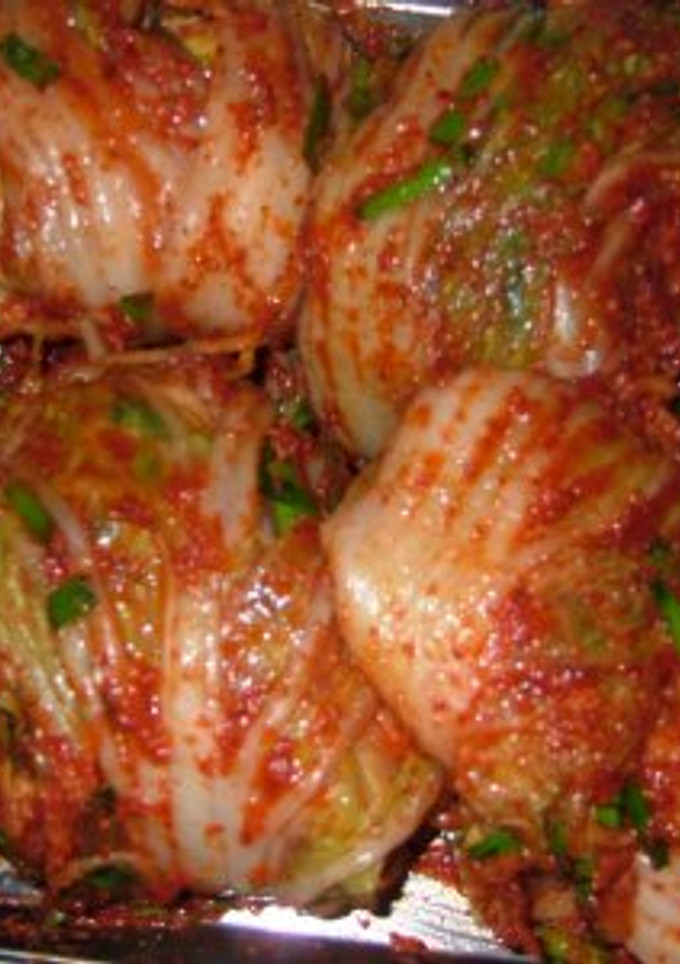Authentic Kimchi

I learned how to make kimchi from 2 Korean friends. Each version tasted different, so I combined the best of both to come up with my own version.
Brine the Chinese cabbage in salt properly beforehand.
The ingredients will keep for more than a month in the refrigerator, so even if you don't use them all up in one batch, if you make another batch before the previous one is eaten up you can alway enjoy delicious kimchi.
Dice some daikon radish, salt it for a little while, and mix with these ingredients to make ggakdugi pickles. Great for kimchi hot pots! Recipe by takaya. (This recipe uses 2 heads of Chinese cabbage.)
Cooking Instructions
- 1
Cut the Chinese cabbage heads into quarters, and salt with 5% of their weight in salt the day before you plan to make the kimchi. (Make sure to put plenty of salt on the tougher root ends.) The next day, when moisture has come out of the cabbage and it is immersed in it, drain off the moisture in a colander.
- 2
Make the additional ingredients. Cut the daikon radish into 4 cm long julienne, sprinkle with salt and leave until wilted. Squeeze out the moisture.
- 3
Cut the green onion and Chinese chives into 3 cm long pieces. Cut the leek into 3 cm long pieces and julienne.
- 4
Put the onion, pear, garlic and ginger into a food processor and process until chopped and combined.
- 5
Soak the konbu seaweed in water until softened, and shred finely. Combine with the scallops, ama-ebi shrimp, and the salt-preserved sardine liquid in a food processor. Process until the shrimp shells are completely chopped.
- 6
From this point on protect your hands with gloves. Sprinkle half the chili pepper onto the daikon radish from Step 2, and mix well until it has all turned red.
- 7
Process the salt-preserved squid in a food processor until it's chopped up. Add this to the Step 6 mixture with the sugar, and squeeze and mix together with your hands.
- 8
Add the Step 5 konbu seaweed and the Step 5 scallop-shrimp mixture and mix and rub it all together with your hands.
- 9
Add the chopped up garlic mixture from Step for and mix it in. Add the rest of the chili peppers and rice porridge, and mix well.
- 10
Add the chopped up green onion, leek and Chinese chives. Mix to combine. The seasoning ingredient mix is finished.
- 11
Next, combine the seasoning mix with the Chinese cabbage. If the cabbage is still wet dry it well with paper towels. Push in the seasoning mix between the leaves of the cabbage.
- 12
Roll up the cabbage pieces, wrap each one with the outermost leaves, and it's done.
- 13
Kimchi is a fermented food, so don't eat it right after you make it. It's best after resting in the refrigerator for at least 4 days. Once it tastes right, store it in the partial freezing compartment (almost freezing) of your refrigerator to slow down further fermentation.
Similar Recipes

Our Homemade Authentic Kimchi


Easy Kimchi


Authentic Easy Kimchi (shellfish-free)


Homemade Kimchi


Korean Kimchi


Korean Kimchi


My Kind of Kimchi


Korean Kimchi from the Source


Flavour of Korea: Simple Homemade Kimchi


Công thức kimchi đơn giản của mình


Homemade Kimchi


Vegan Kimchi


Kimchi


Cucumber Kimchi


Vegan kimchi

Korean-Style Cucumber Kimchi


Homemade Radish Kimchi


Easy Daikon Radish Kimchi


Cucumber Kimchi


Spicy Pinoy-Style Kimchi


Easy Kimchi Soup


Kimchi 🇰🇷


Storeable Homemade Cabbage Kimchi


Vegan kimchi


Easy Daikon Radish Kimchi Stock


กิมจิ (โฮมเมด) Homemade Kimchi ทำทานเองแบบง่าย ๆ


Mul (Water) Kimchi Instant Pickles


Kimchi soup

Radish Kimchi


How To Make Vegan Kimchi








Comments